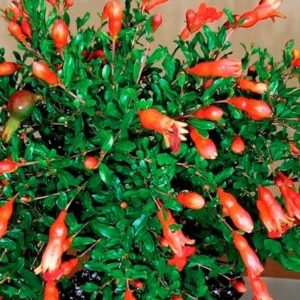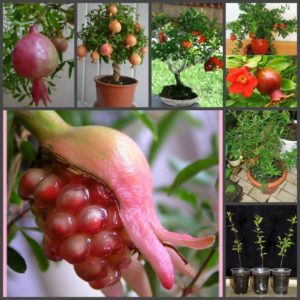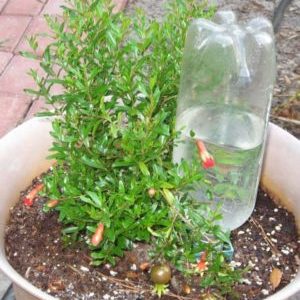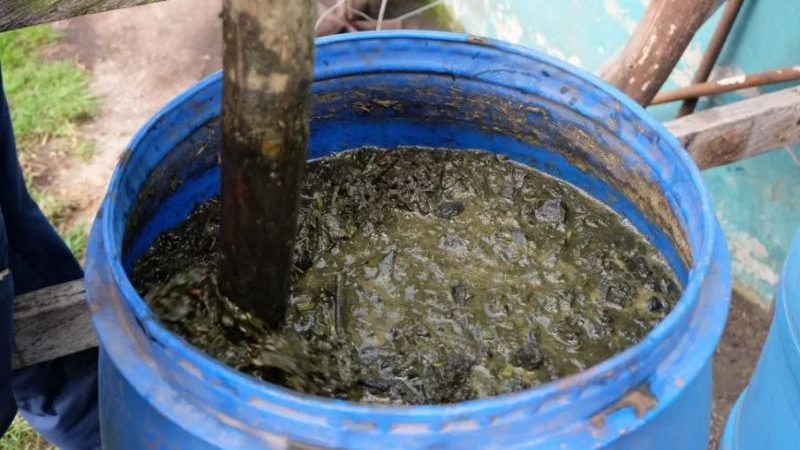What does a pomegranate flower look like and how to care for a houseplant during flowering and fruiting
Anyone who has seen the pomegranate tree bloom will never forget this mesmerizing sight. Sprawling shrubs, tall trees and dwarf houseplants look equally beautiful during this period. Consider how and when a pomegranate tree blooms, how to properly care for it at this stage.
The content of the article
How pomegranate blooms
Pomegranate is a bisexual plant, therefore both female and male flowers are found on it. From the moment of flower formation until its disappearance, only 3-5 days pass, after which new ovaries appear... Thus, the flowering of the pomegranate does not stop, and the tree is covered with flowers all the time. Budding and the appearance of fruits occur almost simultaneously, so in summer the tree is pleasing to the eye.
The palette of pomegranate flowers is presented in 3 shades: scarlet, raspberry and yellow-white. The play of saturation of tones creates a luxurious multicolor. On some trees variegated flowers are found. Their form is so diverse that it is not always possible to determine their belonging.
There are 3 types of wild pomegranate flowers:
- bisexual in the form of jugs, giving fruit ovaries;
- bell-shaped, not fruit-bearing;
- intermediate forms.
Female buds have a wide base and look like a fleshy tube with serrated edges, which remains on a ripe fruit in the form of a small "crown". Pistils are long, located at the level of the anthers. Female flowers appear on last year's shoots. Multi-nested ovaries are formed from accrete carpels. Their edges fold inward and form nests or chambers. In ripe fruits, these chambers are delimited from each other by a white film and are filled with grains.
Male buds short-pistil and conical, resembling bells. The pistil is short, located below the anthers. The flowers are formed on the shoots of the current season, are completely sterile, and fall off after flowering. The ratio of female and male buds on one tree depends on the variety, growing conditions and agricultural technology.
Intermediate flower forms difficult to define. They are in the shape of a bell, cylinder, or jug. The length of the pistil varies from short to long. Flowers with long pistils do not always produce fruit ovaries. In rare cases, when the fetus is nevertheless formed, it has an irregular shape.
When indoor pomegranate blooms

Indoor pomegranate, planted with a stone, enters the flowering phase after 3-4 years, and with a cuttings after 2-3 years. Abnormally early flowering occurs when 1-2 buds appear on the tree, but they do not give fruit ovaries and quickly fall off.
When does pomegranate bloom at home? This happens twice: in April - May and early August. An indoor tree blooms uninterruptedly with luxurious buds just like a wild one. Budding, flowering and the appearance of fruit ovaries is an endless process. The tree with dense buds, bright flowers and crowned fruits looks fabulous.
Care during flowering and fruiting of indoor pomegranate
Indoor pomegranate is unpretentious in care, but the agricultural technique is subject to certain rules that allow for abundant flowering.
Lighting

One of the main conditions for the long flowering of indoor pomegranates is a sufficient level of illumination. In summer, a pot with a tree is taken out to the balcony or garden.An adult plant prefers to bathe in sunlight and does great outdoors. Young seedlings are taught to be outdoors gradually: they are brought out in the sun for 2-3 hours in the morning, and at lunch they are brought back or shaded. This helps prevent sunburn on young foliage.
When placing pots indoors, choose window sills on the south side of the house. At noon, the plants are shaded with curtains or blinds.
Reference. With a lack of sunlight, it is recommended to supplement the pomegranate with phytolamps.
In winter, with a lack of natural light, the tree partially sheds its leaves. However, the organization of lighting with a phytolamp and the creation of a day length of at least 12 hours contribute to flowering and fruiting.
Indoor air temperature
Pomegranate loves warmth and grows naturally at high temperatures. Indoor plants are content with a moderate temperature of + 25 ... + 30 ° C during the period of active growth.
When the temperature in the room rises, it is recommended to move the tree to a cool room. In summer, pomegranates are taken out onto a balcony or veranda, and in spring they are sprayed with cool water. In a hot room, the plant sheds leaves and buds, slows down development. It is recommended to ventilate the room more often to improve air circulation.
The culture does not like low temperatures and dies even in low frost. When the ambient temperature on the balcony or veranda reaches + 15 ° C, the pot is brought into the room.
Watering

Pomegranate prefers moderate watering, so they moisten it after the topsoil dries. To do this, use soft settled water at room temperature.
In winter, during the dormant period, an adult plant is harvested in partial shade and watered once a month, a young one once a week. The frequency of watering is increased from February, after the flower returns to the light windowsill. The soil is completely saturated with moisture to activate the life processes of the plant.
Reference. Before the beginning of flowering, pomegranates are watered abundantly, during the budding period - from May to September - the frequency of watering is reduced, but the moisture level of the upper soil layer is monitored.
In the fall, fruits begin to form, so the tree is watered carefully, since waterlogging leads to cracking.
Air humidity
The optimum air humidity for indoor pomegranates is 60–70%. At lower rates, it is recommended to spray the plant and the air around with cool water. In winter, in the room where the flower pot stands, you can put a humidifier or a container with cold water, carry out wet cleaning of the room and wipe the leaves with a wet cloth.
High humidity, like low humidity, negatively affects the pomegranate. To normalize it, it is recommended to ventilate the room more often.
The soil
In wild nature Garnet grows on scarce soils in arid regions. However, nutrient soil is used to grow indoor specimens. It should be loose, moist and breathable, with a neutral pH = 7. Ready-made soil is suitable for begonias and roses. A thick layer of expanded clay or river pebbles is placed on the bottom of the pot.
Top dressing

Indoor pomegranate is fed with nitrogen-phosphorus fertilizers until the end of spring. During this period, buds are laid and the plant prepares for lush flowering. Top dressing make 1 time in 2 weeks. Closer to autumn, they switch to potassium means. For foliar top dressing, a solution of "Gumisol" is used.
Fertilizer recipes:
- mullein solution - 1:15;
- chicken manure solution - 1:25;
- 1 tsp wood ash per 1 liter of water;
- biohumus (vermicompost) - 250 ml per 10 liters of water;
- 1.2 g superphosphate and 0.5 g potassium per 1 liter of water.
Fertilizers are applied exclusively to wet soil on the second day after watering, in the morning or in the evening, so that the roots do not get burned. In cloudy weather, feeding is allowed during the day.
If indoor pomegranate is grown for the sake of fruit, fertilize is applied carefully.For this, organic matter is used instead of mineral agents so that nitrates do not accumulate in the fruits. It is important to respect the dosage as a grant overfed with nitrogen does not flower or bear fruit.
Pruning

Pruning indoor pomegranate has a positive effect on decorativeness, flowering and fruiting. Given the tendency of the culture to grow rapidly, without pruning, it will double in volume per season, and numerous thin shoots form the crown chaotically. To give the tree a neat and compact look, growers prune several times a year.
The first procedure is performed at the beginning of the growing season. After the winter dormant period, the tree is taken out to a bright place and dry branches and part of small shoots are cut off.
To stimulate branching, young shoots are cut above the outward-facing bud, leaving 4-5 internodes. No more than 6 strong skeletal branches are left on the tree.
Important! The buds form exclusively on developed annual shoots.
Indoor pomegranate allowed to grow a bush with 3-5 skeletal branches. However, if you cut off the root shoots, a tree with a low stem and 4-5 skeletal branches will come out. As the plant develops, 4-5 second-order shoots are laid on each skeletal branch, then third-order branches are formed on them. Excess and old shoots are removed - they will no longer have a crop.
In the summer, during the period of active growth, branches that grow inside the crown or are elongated are cut off. Pomegranate tolerates this procedure without loss. After flowering, if there are no fruits on the tree, one more pruning is performed: thin branches are removed and the crown is thinned inside.
Why pomegranate does not bloom at home
Among the common reasons for the absence of flowers on a pomegranate tree are the following:
- Age under 3 years old... Young plants have not yet accumulated enough nutrients for flowering.
- Not a season. The plant has entered a period of winter dormancy, therefore it does not give flowers.
- No clipping. In January, before the leaves bloom, it is recommended to cut off most of the branches and root growth, to shorten the growing shoots.
- Non-compliance with watering rules... In summer, the plant needs watering every other day or every day, depending on the humidity of the air. In September, irrigation is reduced to 2 times a week, by November - once a week.
- The soil is poor in nutrients. Indoor pomegranate is planted in sod-podzolic soil and do not allow stagnation of water in the pot.
- The pot is too narrow. A wide and shallow container is best for growing pomegranates at home.
- Lack of a dormant period. In nature, the tree begins to shed its foliage and stops growing until the end of February. This respite is required to maintain the vitality of the plant. For indoor pomegranate, 3-4 weeks of rest at a temperature of + 12 ° C is enough for the resumption of flowering.
- Infection with fungi, bacteria and insects. Indoor pomegranate most often suffers from gray mold, powdery mildew, cancer of branches and roots. The plant is attacked by aphids and spider mites. As a result of infection, pomegranates weaken, all forces go to resist pests and diseases, and they are no longer enough for flowering. Any insecticides ("Actellik", "Fitoverm") are used to kill insects. To combat infectious diseases, fungicides and folk remedies are used based on onion peel, crushed coal, potassium permanganate and laundry soap.
Why are there only male flowers on the pomegranate? In an ornamental plant, predominantly short-columnar male flowers are formed. If fruits appear from them, they are inedible.
How to improve flowering
Homemade pomegranate enters the flowering period when it reaches a height of 50–70 cm. A tree grown from seed blooms for 4–7 years, as it needs to adapt to indoor conditions.
To obtain a flowering plant, it is recommended to grow pomegranate from a seed, allow it to rest in winter and follow agricultural techniques. After leaving the dormant period, in March, they begin to form a crown and pinch branches. At the beginning of summer, the first buds will appear on the tree.
Trees older than 4 years old are transplanted into a substrate with the addition of horn shavings and bone meal before flowering. Mature trees that have already bloomed are moved to more fertile soil to maintain flowering. The substrate is prepared from clayey sod soil, compost, leafy soil and sand in a ratio of 3: 2: 1: 1. Manure is placed on the bottom of the pot as drainage. The plant is placed in partial shade and maintain optimum soil and air moisture.
Important! Abundant and long-lasting flowering is facilitated by regular transplanting. Young shoots are transplanted every year into fertile soil, trees over 4 years old - once every 3 years, large plants - once every 5 years.
Every six months, the top layer of the soil is replaced with deciduous humus mixed with chicken droppings. Every 5 years, the pomegranates are renewed by removing old branches.
Additional pollination is recommended to maintain flowering. Pollen from female flowers is carefully collected with a cotton swab and transferred to male flowers. A small number of buds or their complete absence signals that the plant has outlived its varietal characteristics. In this case, grafting branches from a flowering pomegranate will help.
Castor oil bait (1 tsp per 1 liter of water) will help to improve flowering. The resulting solution is watered with a tree during the period of bud formation.
Conclusion
Wild pomegranate is a tree with male and female flowers. Indoor specimens often contain only male flowers, which rarely bear fruit.
Blooming pomegranates look attractive no matter where they are grown. At home, it is easy to maintain abundant flowering, subject to agricultural practices. An indoor plant needs regular watering, adequate lighting, maintaining air humidity, dormancy and pruning.